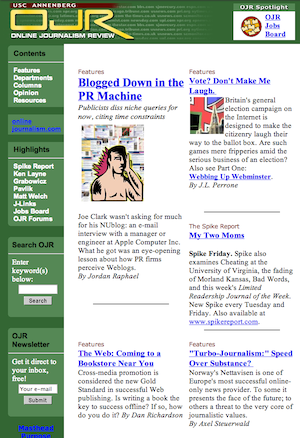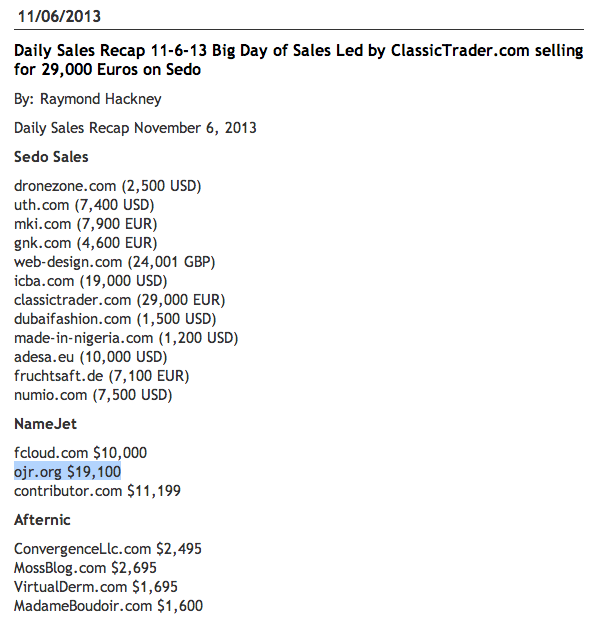Nieman Journalism Lab |
- The new Chicago magazine is attracting design clients
- The Atlantic Wire gets a new (shorter) name and a new look
- OJR.org: An opportunity to watch a spamblog be built in real time
| The new Chicago magazine is attracting design clients Posted: 19 Nov 2013 11:33 AM PST Chicago magazine redesigned its website last month, making all the usual changes, from a new typeface to bigger photos, a cleaner layout, and a responsive mobile page. In a post on the Society for News Design’s blog, Luke Seeman, who headed up the new design, discusses why they changed the look of the site, and the need to have a dialogue with readers about the process. In the interview with Rachel Schallom, a designer with the South Florida Sun Sentinel, Seeman says one surprising result of the new look has been the possibility of doing outside design work.
|
| The Atlantic Wire gets a new (shorter) name and a new look Posted: 19 Nov 2013 11:12 AM PST Goodbye The Atlantic Wire; hello, The Wire. In relaunching its breaking news focused aggregator, Atlantic Media decided to take its name off the door in favor of creating an independent, more compact brand. It’s not a case of abandonment, but an attempt to keep in step with the way the news site has tried to operate for the last four years: short and to the point. It’s a new name, a new URL (thewire.com), and a more mobile-friendly look that adapts to almost any screen size. As The Atlantic Wire, the site made its name as a breaking news feed that pointed readers to the day’s top stories and best writing — aggregation with a higher value-add than your typical headline-and-blockquote engine. As The Wire, The Atlantic wants to build a news service that can thrive in the era of social media. As The Wire editor Gabriel Snyder, sees it, the overall goal isn’t changing that much. “I want to make The Wire a place where you can catch up quickly on whats going on in the world,” Snyder said. Social channels have changed the way people discover and consume news, and also changed the process for newsgathering and delivery, Snyder said. “The Wire is founded on this idea that we live in an age where people are media omnivores,” he told me. While The Atlantic name is going away, it’s not difficult to see The Wire in the context of the broader Atlantic Media company. Over the past several years, Atlantic Media has branched further away from its magazine mothership, adding several independent sites to its family, including Quartz and Defense One. The Atlantic Wire was one of the company’s first experiments in spinning off an online brand from the 156-year-old magazine; now the company is employing lessons from expanding portfolio to distinguish The Wire as an entity of its own. As part of the relaunch, The Wire will have a dedicated staff for ad sales. According to the company, the site now averages 6 million monthly unique visitors, with 40 percent of the site’s traffic coming from mobile. Over email, M. Scott Havens, president of The Atlantic, said the site is ready to step out on its own. “It's less about removing The Atlantic from the name and more about establishing The Wire’s independent identity in both form and function,” Havens said. “Over the last four years, The Wire has grown and evolved and has now established itself as a go-to news platform for millions of readers.” The Wire’s new look is responsive to meet the needs of readers on different devices. The homepage is designed to help readers navigate the big need-to-know stories of the day. In place of the usual navigation bar at the top of the page with fixed topics or sections, The Wire features a changing collection of topics that reflect the day’s news. Snyder calls it “story-based navigation.” (It’s sticky, which not everyone likes.)  The old Atlantic Wire. The homepage now also offers more slots to showcase top stories, and options to sort stories by what’s trending (using social sharing stats), what’s popular (clicks), or chronological order. Article pages get a refresh as well, with a wider story well, larger fonts, and a healthy dose of links to additional stories on the site. Snyder told me that homepage traffic for the site is growing, but they also wanted to offer more ways to push readers deeper into the site. (It’s also worth noting that the redesign hides comments by default, a larger trend we’ve seen across a lot of site. The last redesign of The Atlantic doesn’t hide comments, but it buries them underneath a giant stack of story promos.) The homepage layout, a grid photos and clever headlines, gives The Wire a look similar to social media friendly sites like Digg. (Or: “Digg, but more confusing?”) Snyder said it’s a design oriented for different types of audiences, from the savvy reader who reads multiple sources each day, to those looking for a one-stop read. “I kind of think of our audience as rings of concentric circles, going from the outer ring of someone who clicks a link and arrives at the site having no idea who we are and what it’s about, down to the inner core, the people who have made it a habit to come to the site every day or multiple times a day,” Snyder said. As a news site, The Wire is mostly a generalist, focusing on stories in politics, business, technology, and culture. The differentiator, Snyder says, is their approach, which prizes concise writing and smart aggregation. That strategy is what set The Wire apart from its parent magazine in the beginning, Havens said. “The Atlantic, in both the magazine and online, primarily provides original analysis and insight, whereas The Wire is a real-time filter of news and information, helping readers absorb the day’s top stories, voices, and opinions — and understand the context, quickly,” he said. You’re not going to find latest-news updates on The Atlantic on a given day. Similarly, you’re not going to find the defined brands of a James Fallows, Ta-Nehisi Coates, or Alexis Madrigal. But over the years the connection between the two sites generated some confusion, both over the relationship between them and the editorial structure. The overlap between the audiences of the two sites is fairly small, Snyder told me. What the two properties share, he said, is the same philosophy on writing, reporting, and editorial integrity. But the audiences are distinct, he said. “Confusion is what were trying to address. It’s not clear from our current branding that The Wire is produced by a separate editorial team,” he said. If there’s one thing Atlantic Media is looking for right now it’s clean and clear lines between its properties. The company wants each title to be ambitious, resourceful, and free to develop its own audience and money-making possibilities. Havens said the best way to do that is to make the brands independent and “free the team from too much bureaucracy, and encourage the group to foster its own culture of innovation.” The media environment hasn’t become any less crowded in the four years since The (Atlantic) Wire was first born. News consumers wield even more power over the way their news is delivered and how they read it. Snyder said the redesigned Wire is meant to not just adapt to readers’ device preferences, but also their news consumption habits. “Everyone has their niche interest, but I think there’s still a hunger for a wider understanding of what’s going on in other people’s niche interests,” Snyder said. |
| OJR.org: An opportunity to watch a spamblog be built in real time Posted: 19 Nov 2013 09:16 AM PST
In the hours since my story went up, there’ve been a few updates. — I received a statement from USC Annenberg about the snafu:
— Oneflare, probably rightfully scared of the litigation it would otherwise be asking for, removed the legally dubious material from OJR.org. They removed the OJR archive stories and the USC logos and changed the site name from "Online Journalism Review" to "Online Journal Review," whatever that means. So the site is now solely a spamblog, rather than a spamblog cloaked in an old journalism website. Progress, maybe? — We have some evidence for what price OJR.org went for. The domain was put up for auction at NameJet (“The Premier Aftermarket Domain Name Service”) after it was allowed to lapse. This roundup of domain sales from November 6 reveals the price it went for: $19,100.
(Wow.) OJR.org had also been listed in October on a list of high-value expired domains — high value because it had been registered back in 1997, which gives it better Google juice. — Perhaps because it’s hard to step away from a $19,100 purchase, OJR.org continues to evolve as a spamblog. It’s actually a rare opportunity to watch a spamblog be built in real time — normally you only find them after they’ve been doing their dark magic for a while. Along with the original article promoting Oneflare, Lim (or whoever’s running the backend) has added five new articles to give the illusion of a real site. (Something had to take the place of all those old OJR stories, I imagine.) The stories don’t have spammy links yet, but they are artificially backdated (as far back as 2011) to give the illusion of a long-existing website. (They also look like algorithmically altered versions of existing stories — weird synonyms subbed in where they should be, for instance — but I couldn’t find any original versions with a few quick searches.) — There’s one other side benefit to building a spamblog on an old news brand like OJR: OJR content is whitelisted into Google News. So, for instance, one of the new spam articles is about the Garmin Forerunner 610. Search for “garmin” on Google News and look what the third result is:
That means the main work to be done now is Google’s. It needs to remove OJR from Google News, and it needs to eliminate the PageRank advantage that the old site built up for the new one. From there, it’s USC’s move on what to do with those remarkable disappeared archives. |
| You are subscribed to email updates from Nieman Journalism Lab To stop receiving these emails, you may unsubscribe now. | Email delivery powered by Google |
| Google Inc., 20 West Kinzie, Chicago IL USA 60610 | |
 In case you didn’t see
In case you didn’t see 
